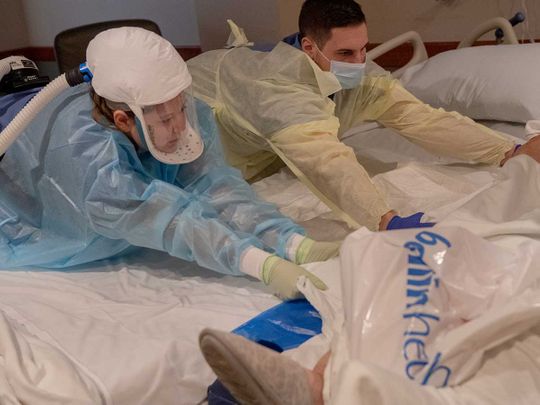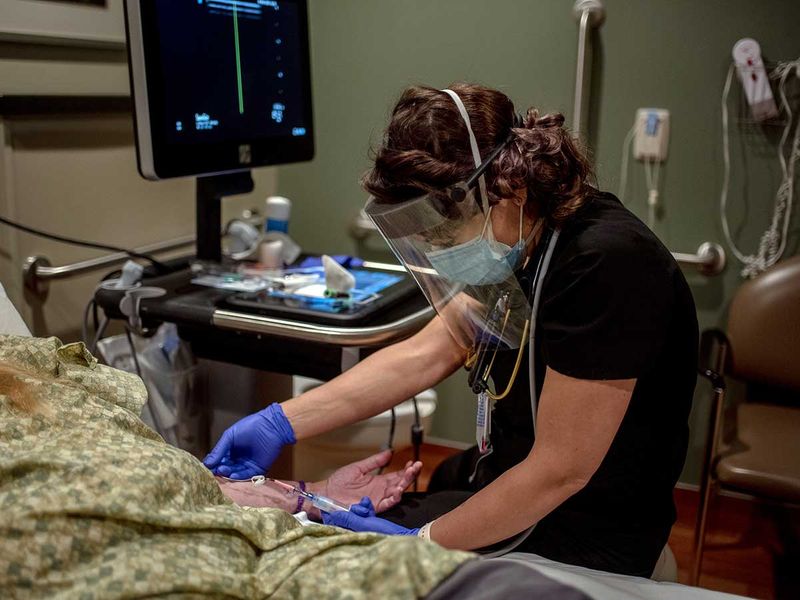
Washington: As the coronavirus cut a devastating path around the country, Laura Liffiton, 32, found herself racing along behind.
She arrived in New York City in April, on one of the worst days of the pandemic, for a stint as a nurse in the overrun intensive-care unit of a crowded hospital. After her contract there ended, she flew in July to another hot spot with an urgent need for nurses: a hospital in Arizona where four of her patients died of the coronavirus on her first day. In October, Liffiton travelled on, to Green Bay, Wisconsin, just as the virus was surging uncontrollably throughout the Midwest.
“When the pandemic began, I thought, ‘I’m going to go help, I can do some good, I can make some good money,’” she said. But on the first day of treating coronavirus patients, Liffiton remembered, “I was like Dorothy landing in Oz. I was totally unprepared for the reality.”
As the coronavirus has spiked across the US - leaving a record 100,226 Americans hospitalised Wednesday - travel nurses, who work on temporary contracts for higher fees and move from city to city, have become more urgently needed than ever.
More deaths were reported Wednesday than on any other day of the pandemic, surpassing the single-day death record of 2,752, set in April. And federal officials suggested that the picture may grow still worse in the months ahead. Dr Robert R. Redfield, director of the Centres for Disease Control and Prevention, warned that the nation was facing a devastating winter, predicting that total deaths from COVID-19 could reach “close to 450,000” by February unless a large percentage of Americans follow precautions like mask-wearing.
“The reality is, December and January and February are going to be rough times,” Redfield said. “I actually believe they’re going to be the most difficult time in the public health history of this nation.”
Demand for travel nurses
As hospitals fill with virus patients, the biggest need has been finding enough staff to tend to the critically ill. Demand for travel nurses has increased by more than 40 per cent in the past month, according to Aya Healthcare, an agency based in California that dispatches them to hospitals. At least 25,000 nurses work in travel nursing, though the number fluctuates, and hospitals have depended on them for decades.
It is a nomadic existence and, in a pandemic, a particularly high-risk one. The nurses parachute into cities like New York, Phoenix, Los Angeles and Green Bay for weeks or months at a time, quickly learning the ways of a new hospital and trying to earn the trust of the existing staff.

At the end of their shifts, they return to their temporary homes: hotels, Airbnb apartments or rented houses. Their families and friends are sometimes thousands of miles away, available only through phone calls or FaceTime.
Last week in Green Bay, where the surrounding county has averaged more than 150 cases a day since late September, a team of four travel nurses worked at Bellin Hospital, grappling with the unrelenting pressure of the emergency room and a Thanksgiving holiday far from home.
More than eight months into the pandemic, many travel nurses have done little else but treat COVID-19 patients.
Liffiton still shudders when recounting what she saw in New York in April: doctors and nurses who were overwhelmed, rows of intubated patients and little sense of when the devastation would end.
She still sleeps only about four hours a night, troubled by what she has seen throughout the pandemic.
“It’s hard,” she said. “Even after I leave a place, the feelings stay.”
Morgan Fitzsimmons, a travel nurse who is based in Lake Geneva, Wisconsin, has been treating coronavirus patients since a stint working in Syracuse, New York, in July. In Green Bay, where she is temporarily based, the weather has now turned cold and blustery. Some people are still gathering indoors, going to bars and to restaurants and weddings.
“The hospital’s getting tight,” said Fitzsimmons, who is 26. “Half of your patients that you’re going to see in a day more than likely have COVID or are getting tested for COVID. They’re coming in and getting tested. They go home and then they get sicker and they come back.”
Travel nursing pays well
John Deaton, 27, has spent most of his nursing career as a traveller, as they are commonly called.
Throughout the pandemic, he has treated COVID-19 patients and even caught a mild case of the virus himself, working in El Centro, California, near the border with Mexico; Sacramento, California; and now Green Bay.
Places to stay in northeastern Wisconsin were difficult to find. He settled for renting the basement in a house while the owner lives upstairs, negotiating for shared use of the kitchen so he would have more than a microwave to use for cooking.
Deaton, who is from Akron, Ohio, was attracted to travel nursing because it pays so well - he estimated that he makes four times what he would earn if he accepted a staff position somewhere. There is a range of pay for such work, but a weekly paycheck could be more than $5,000 during the pandemic, by some of the nurses’ estimates, in addition to benefits.
“I think this attracts a couple different personality types,” he said. “I travel for the money. Some people travel to travel - they like being in other places, they want the locations of San Diego or Hawaii.”
The dynamic between staff nurses and travel nurses can be complicated. Deaton said that when he was in Sacramento, staff nurses were given higher-quality equipment to use, such as air-purifying respirators, that travel nurses had to repeatedly request.
“We’re here because they have a need,” he said of hospitals. “We’re not people that are going to be here later on.”
On Dec. 19, Liffiton’s contract in Green Bay will be finished, and she will head back home to rest and spend time with her family.
A week after that, she is back to New York for a 13-week hospital assignment.
“It’s a little frustrating that I’m still going back,” she said. “So many of the people in New York are already doing such a good job of quarantining. And yet this is still a problem there.”








